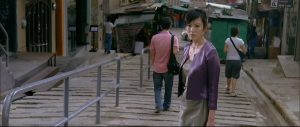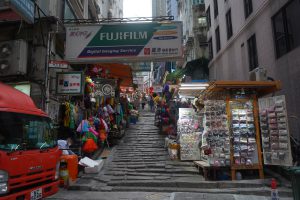SPARROW, DIR. JOHNNIE TO (2008)
Pottinger Street, Central, Hong Kong

The heroine Chun-Lei looks back at the hero’s camera when she runs down Pottinger Street. Scenes from the Sparrow 2008, directed by Johnnie To.
Sparrow, directed and produced by Johnnie To, was released in 20081. The movie tells the story of a charming woman, Chung Chun-lei, and four pickpockets 2, with whose help Chun-lei eventually gains freedom from a controlling businessman. The camera follows Chun-lei as she gracefully rushes through the streets in Sheung Wan and Central, when she runs into the lens of Kei, the leader of the pickpockets, at Pottinger Street. The part of the street which connects Queen’s Road and Hollywood Road is quite steep and consequently is paved by stone slabs to facilitate pedestrians and drainage. Also called Stone Slabs Street, it is one of the oldest historical streets in Central and has appeared in many famous Hong Kong movies including Infernal Affairs III (2003) and Lust, Caution (2007).
In the movie, the street is depicted as a romantic scene for “falling in love at first sight”, where stunning looking-backs of the heroine are captured by hero’s Rolleiflex as she running down the steps. There are fewer people walking past than the two busy roads that it connects, which facilitate this encounter. The street is, however, still an everyday space that can be under regular reconstruction, with houses, mailboxes, and passing-by commuters. While nowadays Pottinger Street has become a famous scenic spot because of its history and high exposure in movies. Tourists visit and take photos here to imagine or imitate the theatrical atmosphere. Many of the side buildings become cafés or restaurants, with numbers of small stalls on both sides. Additionally, listed as a protected historical construction by local government, it provides a sense of vicissitude and to some extent represents the landscape of colonial Hong Kong.



Right: Small shops selling souvenirs and small commodities take up the sides of the street at its lower part, leaving narrower spaces for pedestrians. Middle: This is the entrance in the middle of the street where the hero sets up his camera on a tripod and takes the photos of the entering heroine. Left: The surface of the stone slabs seems more smooth and darker with the pass of time, while the overall view of the street does not obviously change.
Sparrow is not only a classical Hong Kong romantic or gangster movie, but also a graceful record of the historical cityscape. At the beginning of the movie, the indexical black-and-white photos taken by the hero provide audiences chances to see the scenes of city life in a different but authentic way. These “memento mori” works add to the sense of theatricality and nostalgia3, particularly in the hero’s capture of the running-away beautiful heroine. When both the heroine and sparrow fly away at the end of the movie, certain poetic beauty of the city also disappears and is only left in photography. Choosing the old Pottinger Street as a significant scene, Johnnie To emphasizes this pitiful disappearance throughout the urbanization process and tries to recollect them by images4. Although more commercial elements now appeared in the street, the overall historical atmosphere has not completely faded away. Consequently, Sparrow, together with other movies shotting in Pottinger Street, might create a positive “reappearance” for the street, which is now perceived as a cinematic space with retrospective beauty.
The street is not a very long one but quite steep. Under the Covid-19 situation, there are not many tourists as well as citizens.
Notes:
1 Produced by Universe Entertainment and Milkyway Image, the movie is starred Hong Kong actor Simon Yam and actress Kelly Lin. It was first released as a selected work at the 58th Berlin International Film Festival in February 2008 and was later screened in Hong Kong in June.
2 In Cantonese, “sparrow” also means pickpockets. At the beginning of the movie, a sparrow flies into Kei’s room and reluctantly to live, which is considered as a miserable omen. Sparrows also appeared later as clues and symbols in the tea café and roadside trees. Nowadays the expression of “sparrow” as thieves is less used by the younger generation.
3 Susan Sontag, “In Plato’s Cave,” in On Photography (New York: Anchor Books, 1977), 3-24.
4 M. A. Abbas. “Building on Disappearance: Hong Kong Architecture and Colonial Space.” In Hong Kong: Culture and the Politics of Disappearance. (Hong Kong: Hong Kong University Press,1997),63-90.
— CHEN Quanchi, 3035637395
A good attempt at identifying Pottinger Street as a space of the romantic encounter in the film and that of an archive – “a good record of the historical cityscape” – as indexical record of the city over time. I enjoy your reading of the photographic as the only record of the city and its stories left when time is passed in reflecting on the continual onslaught of new development on the actual street. What is this nostalgia you are referring to that the film? You seem to suggest that this is done through the recollection of images. How does the film camera capture the street? What details, if any, does it focus on and how does it do it? Consider, for example, the framing of the shots and how it captures the human subject, the ground and the flanking shops and their activities, to discuss your point on the “sense of theatricality and nostalgia.” Do you feel it when you visit the actual site? Your concluding statement on the film being able to offer a “positive reappearance of the site” is intriguing. How, if so, is this related to the production of nostalgia through the “cinematic space with retrospective beauty”? This calls for further reflection on Abbas’ twin notion of disappearance and reappearance in relation to Sontag’s discussion on “memento mori.” Finally, with regard to the clip here showing the camera swiveling from downward view (towards Queen’s Road) onto the stone steps of Pottinger Street and then upwards towards Stanley Street, why do you think it is placed behind the rusty metal grilled door and to what dramatic effect? In what ways are you using this scene to evidence your discussion on theatricality and nostalgia and/or disappearance and reappearance?